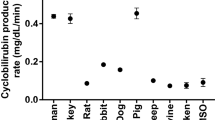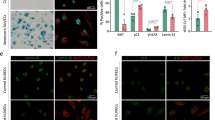Abstract
ROSE bengal as well as bromsulphalein and indocyanin green are utilized for the study of liver chromo-excretion. Changes of these dyes in the organism were intensively studied and it was ascertained that bromsulphalein is conjugated with glutathione and excreted in the bile. Similar metabolites were not proved for rose bengal and indocyanin green. In earlier work we described the isolation of the pure tetra-chloro-tetra-iodo-fluorescein from the commercial preparations of rose bengal1,2. We ascertained further that up to 8 per cent of 131I is split off after the intravenous application of rose bengal, labelled with 131I, to rats, and that it is excreted as a colourless compound in the urine. We have since studied the de-iodination of rose bengal-131I in vitro by homogenates of heart, liver and bone muscle in conditions described by Georgi and Hartmann3 for thyroxine and di-iodotyrosine de-iodination. Our work was stimulated by a certain similarity in chemical structure between rose bengal and these compounds. We homogenized the organs (heart, liver, muscle) from 10 rats by pulverizing with liquid air and mixing with 0.2 phosphate buffer at pH 8.0 so that the total organ concentration was 0.03 g/ml. calculated for the wet organ weight.
This is a preview of subscription content, access via your institution
Access options
Subscribe to this journal
Receive 51 print issues and online access
$199.00 per year
only $3.90 per issue
Buy this article
- Purchase on Springer Link
- Instant access to full article PDF
Prices may be subject to local taxes which are calculated during checkout
Similar content being viewed by others
References
Jirsa, M., Čs. farmacie (in the press).
Jirsa, M., and Raban, P., Nature, 195, 1100 (1962).
Georgi, P., and Hartmann, N., Hoppe-Seyler's Ztschr., Physiol. Chem., 325, 173 (1961).
Suzuki, M., Ishikawa, I., Shimizu, S., and Yamamoto, K., Biochim. Biophys. Acta, 51, 403 (1961).
Ishikawa, I., Gunma J. Med. Sci., 10, 187 (1961).
De Escobar, G. M., Del Rey, F. E., and Rodriguez, P. L., J. Biol. Chem., 273, 2041 (1962).
Author information
Authors and Affiliations
Rights and permissions
About this article
Cite this article
RABAN, P., GREGORA, V. & JIRSA, M. Rose Bengal De-iodination in vitro. Nature 204, 885–886 (1964). https://doi.org/10.1038/204885a0
Issue Date:
DOI: https://doi.org/10.1038/204885a0
Comments
By submitting a comment you agree to abide by our Terms and Community Guidelines. If you find something abusive or that does not comply with our terms or guidelines please flag it as inappropriate.



